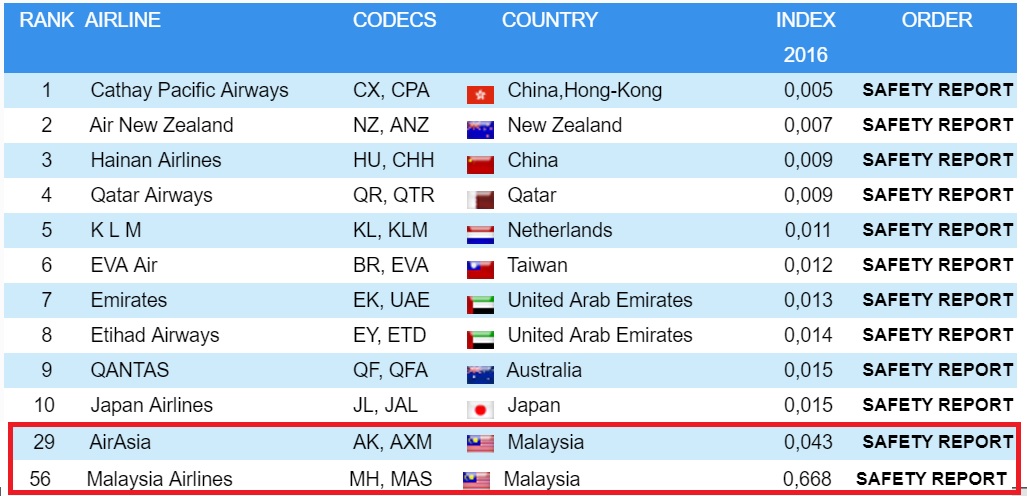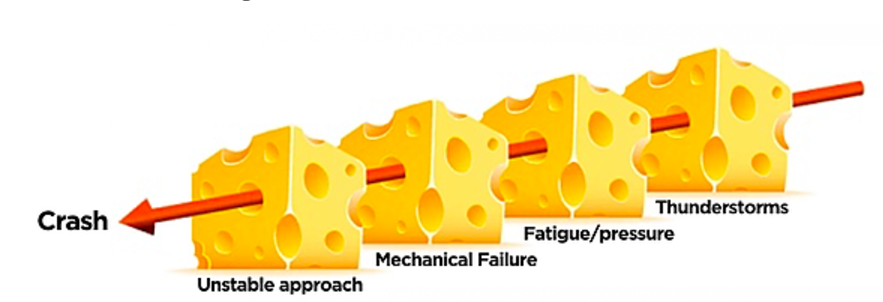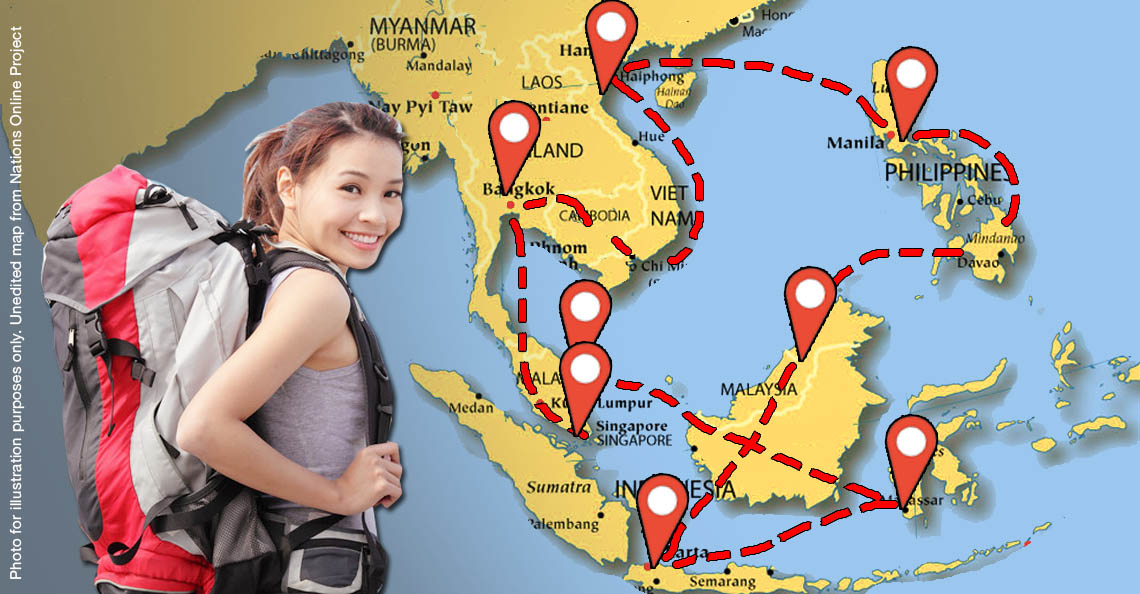Are Malaysian planes really that dangerous? We compare them to other countries

- 1.3KShares
- Facebook1.1K
- Twitter15
- LinkedIn33
- Email41
- WhatsApp87
While some of us were enjoying ourselves and kicking back during the Hari Raya holidays, the image of Malaysia’s airline industry was struck with another incident.

AirAsia X’s Airbus D7237 was flying from Perth to KL for about 90 minutes… Suddenly, passengers heard a loud explosion before the plane started shaking “like a washing machine“. Thankfully, the plane managed to turn back and it landed safely. Though no one was hurt, they were left stranded at the airport and forced to spend hours in the waiting line to catch another plane.
Malaysian plane accidents have turned into a frequent sighting in the news – flights turning back and planes skidding on the runway have become something we come to sort of expect. So we wondered, is there actually something wrong with Malaysian planes? And how safe are they compared to other countries?
While we’re not among the unsafest airlines, we had 2 of the deadliest accidents
We found only 2 sources that attempt to rank world airlines according to safety. Airlineratings.com is the only website in the world that provides aviation safety and product ratings. According to them, iconic Malaysian airlines AirAsia and MAS were not among the top 10 unsafest airlines, but they were not among the top 10 safest either. In historic terms, we are not at the top either.

The website ranks airlines based on a number of criteria, including fatalities in the past 10 years, and whether its on the EU banlist. Their criteria is comparatively simple because in some areas, points are given based on a yes or no basis. But in terms of safety, AirAsia (the main one) scored 4 out of 7, while MAS got 5 out of 7.
On the other hand, a German rating system known as Jet Airliner Crash Data Evaluation Centre (JACDEC), uses a “complex formula” and considers more criteria in their ranking than the airlineratings.com. However, the list of 60 airlines JACDEC selected are the largest airlines based on their passenger volume, and the safety is emphasized more in the safety index than in the ranking.

In their ratings, AirAsia got a higher rating than MAS, and AirAsia was even in the top 30! AirAsia was in 29th place while MAS was in 56th, and AirAsia scored significantly better than MAS according to the numbers.

So it seems that when it comes to the safety of our airlines, it really depends on who you are asking and what criteria they’re judging with. But what about Malindo and Firefly? Well, since they’re relatively new and not as big a company as the other 2, they are sadly excluded from these rankings. Also, MAS is actually the parent company of Firefly, so you could include it under MAS.
Still, since the double tragedy in 2014 involving MH17 and MH370, Malaysia now has the 7th and 18th worst aviation accidents in history, according to the Aviation Safety Network.
AirAsia has more planes but MAS planes are younger… but does age matter?

In the JACDEC ranking criteria, one of the criteria considered is the country’s transparency in reporting investigations and accidents, and it’s really no surprise to find that Malaysia was among the countries that scored low in this aspect.
” Countries that do not or only sporadically publish accident investigations , got a lower rating , such as China , Malaysia, Thailand and Turkey. ” – JACDEC reported
But thankfully, we did find some kind of Tinder for airlines, that gives you a general profile of any airline you can think of. According to them, the MAS fleet currently has around 80 planes, with an average fleet age of 5.1 years. AirAsia is trickier, because it has 2 main companies in Malaysia (AirAsia and AirAsia X), and many other subsidiaries in other countries.

Looking at only the Malaysian ones, AirAsia has a total of 99 planes, with the average age of 6.4 years in AirAsia and 4.6 years in AirAsia X. How does this compare according to JACDEC’s number 1 ranking airline? Cathay Pacific Airways from Hong Kong has 145 aircraft, and an average fleet age of 7.8 years! So age really isn’t a big factor here.
If we consider other airlines under their subsidiaries, you would have to add another 112 planes to AirAsia’s total, and another 21 planes for MAS from Firefly. Even then, AirAsia actually has more than twice the number of planes than MAS. So is it really a surprise if AirAsia has more share of the accidents?
And if we compare number of crashes/deaths, MAS would come out on top simply because it has been around since 1947. Even so, AirAsia has been gaining a lot of attention because of a string of unfortunate events, and people are starting to take notice.
Actually, how worried should we be about dying in a plane crash anyway?

Although reading all the news lately might leave you feeling very concerned about taking a commercial plane, the truth is far from what it may seem. In the previous JACDEC report, a total of 321 fatalities, 376 incidents, 219 serious incidents and 37 hull losses were reported among the carriers surveyed, out of about 3.5 billion air passengers flights.
To prove the point, here are some statistics to help you understand the odds:
- Being in a plane crash: 1 out of 1,200,000.
- Dying in a plane crash: 1 out of 11,000,000
- Getting struck by lightning: 1 in 1,083,000, slightly higher if you’re in Subang Jaya.
- Dying in a car accident in Malaysia: 1.7 in 100
A lot of thought and safety measures are actually put into a commercial plane’s design. Almost all of the system on a plane have a back up system in case the current one fails. Engines, air conditioning units, hydraulic systems and even the computer system are some of the things that have one. A plane is in fact designed to fly with even just one engine.
If you’re still feeling shaky about flying, you can find some relieve in the fact that it usually takes more than one reason to crash a plane. It’s usually several factors to add up instead of just one particular reason. This is known as the “Swiss Cheese Model” in the industry.

Also, under something known as The Montreal Convention, compensation and protection for air travelers are guaranteed. In case of any deaths, the airline is liable to pay up to approximately €130,000 (RM637,000) in damages.
“The carrier is liable for damage sustained in case of death or bodily injury of a passenger upon condition only that the accident which caused the death or injury took place on board the aircraft or in the course of any of the operations of embarking or disembarking.” – The Montreal Convention
But that’s only if you can prove that the airline is at fault. In fact, court battles for MH370 are still on going for some of the victim’s families, despite that there are some that have already settled. On the other hand, the MH17 tragedy was more clear cut, and MAS has already struck a deal with the families last year.
Actually, more than half of plane crashes happen because of human error

Simon Ashley Bennett, director of the Civil Safety and Security Unit at the University of Leicester has shared the 5 main reasons why plane crashes occur, and he revealed that about 50% of plane crashes occur due to pilot error.
“Because pilots actively engage with the aircraft at every stage of a flight, there are numerous opportunities for this to go wrong,” – Simon Ashley Bennett wrote in The Conversation
However, Mr.Bennett reminds us that pilots are the last person standing between the passengers and certain death when something goes wrong. He uses the example of Captain Chesley Sullenberger, who landed his plane safely in the Hudson river after it collided with a flock of geese.

The second reason is, of course, technical issues, which accounts for 20% of plane losses. Even though the quality of manufacturing and technology have been improving, technical failures can still occur. Sometimes, new technology and parts can even introduce new kind of failures.
Weather and sabotage ranks 3rd and 4th at around 10% each, while the remaining 10% is attributed to OTHER human errors made by air traffic controllers, dispatchers, loaders, fuellers or maintenance engineers.
In the end, it’s just impossible to predict when and where such tragedies would strike, and it takes incredible bad luck to actually die in a plane crash. The best prevention against it is for airline companies to take responsibilities for their aircraft’s services, and for common people to be prepared just in case we find ourselves to in this kind of bad luck.
- 1.3KShares
- Facebook1.1K
- Twitter15
- LinkedIn33
- Email41
- WhatsApp87



